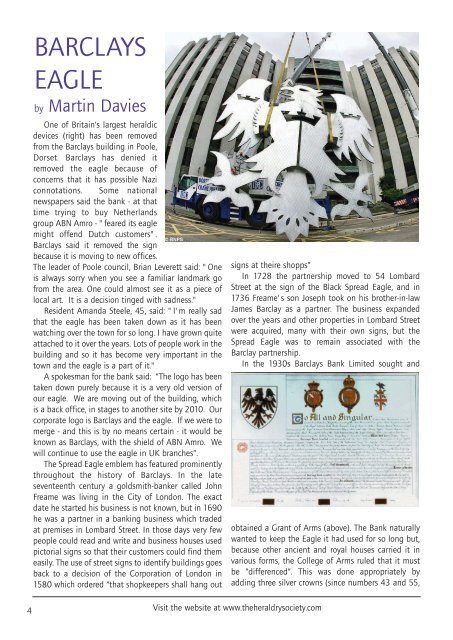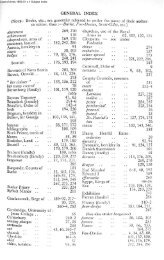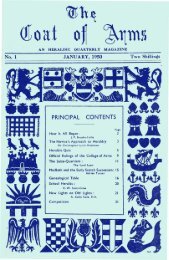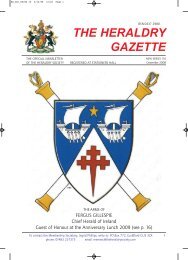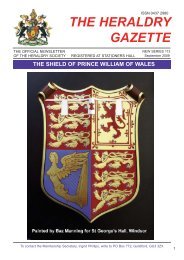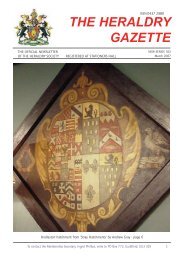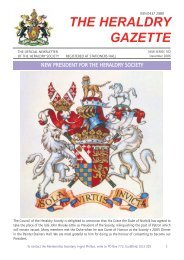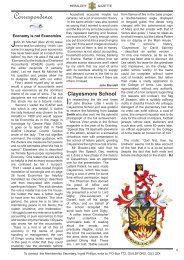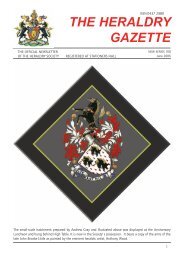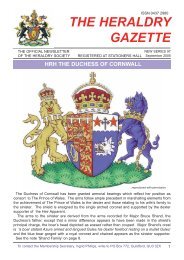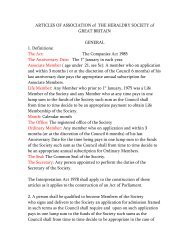Create successful ePaper yourself
Turn your PDF publications into a flip-book with our unique Google optimized e-Paper software.
4<br />
BARCLAYS<br />
EAGLE<br />
by Martin Davies<br />
One of Britain’s largest heraldic<br />
devices (right) has been removed<br />
from the Barclays building in Poole,<br />
Dorset. Barclays has denied it<br />
removed the eagle because of<br />
concerns that it has possible Nazi<br />
connotations. Some national<br />
newspapers said the bank - at that<br />
time trying to buy Netherlands<br />
group ABN Amro - "feared its eagle<br />
might offend Dutch customers".<br />
Barclays said it removed the sign<br />
because it is moving to new offices.<br />
<strong>The</strong> leader of Poole council, Brian Leverett said: "One<br />
is always sorry when you see a familiar landmark go<br />
from the area. One could almost see it as a piece of<br />
local art. It is a decision tinged with sadness."<br />
Resident Amanda Steele, 45, said: "I'm really sad<br />
that the eagle has been taken down as it has been<br />
watching over the town for so long. I have grown quite<br />
attached to it over the years. Lots of people work in the<br />
building and so it has become very important in the<br />
town and the eagle is a part of it."<br />
A spokesman for the bank said: “<strong>The</strong> logo has been<br />
taken down purely because it is a very old version of<br />
our eagle. We are moving out of the building, which<br />
is a back office, in stages to another site by 2010. Our<br />
corporate logo is Barclays and the eagle. If we were to<br />
merge - and this is by no means certain - it would be<br />
known as Barclays, with the shield of ABN Amro. We<br />
will continue to use the eagle in UK branches”.<br />
<strong>The</strong> Spread Eagle emblem has featured prominently<br />
throughout the history of Barclays. In the late<br />
seventeenth century a goldsmith-banker called John<br />
Freame was living in the City of London. <strong>The</strong> exact<br />
date he started his business is not known, but in 1690<br />
he was a partner in a banking business which traded<br />
at premises in Lombard Street. In those days very few<br />
people could read and write and business houses used<br />
pictorial signs so that their customers could find them<br />
easily. <strong>The</strong> use of street signs to identify buildings goes<br />
back to a decision of the Corporation of London in<br />
1580 which ordered “that shopke<strong>ep</strong>ers shall hang out<br />
signs at theire shopps”<br />
In 1728 the partnership moved to 54 Lombard<br />
Street at the sign of the Black Spread Eagle, and in<br />
1736 Freame's son Jos<strong>ep</strong>h took on his brother-in-law<br />
James Barclay as a partner. <strong>The</strong> business expanded<br />
over the years and other properties in Lombard Street<br />
were acquired, many with their own signs, but the<br />
Spread Eagle was to remain associated with the<br />
Barclay partnership.<br />
In the 1930s Barclays Bank Limited sought and<br />
obtained a Grant of Arms (above). <strong>The</strong> Bank naturally<br />
wanted to ke<strong>ep</strong> the Eagle it had used for so long but,<br />
because other ancient and royal houses carried it in<br />
various forms, the College of Arms ruled that it must<br />
be “differenced”. This was done appropriately by<br />
adding three silver crowns (since numbers 43 and 55,<br />
Visit the website at www.theheraldrysociety.com


